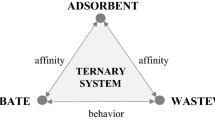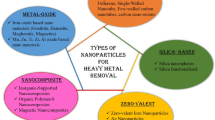Abstract
The present study analyzed the removal efficiency of Cr(VI) from synthetic and pharmaceutical wastewater streams using an adsorption technique by magnetite coated sand. In this context, batch experiments were performed using synthetic and pharmaceutical wastewater to analyze the influence of contact time and adsorbent dose on the removal efficiency of Cr(VI) in two different phases. Magnetite nanoparticles (Fe3O4) coated sand adsorbent was prepared by the coprecipitation method. The performances of the two batch reactors treating synthetic and pharmaceutical wastewater were compared to analyze the influence of contact time and adsorbent dose on Cr(VI) removal efficiency. In particular, different conditions of contact time and adsorbate concentration on the sorption process were studied. The adsorbent materials were further characterized by field emission scanning electron microscopy (FESEM), and the analysis of the Cr(VI) was analyzed using an inductively coupled plasma mass spectrometer (ICP-MS). Results obtained from the first phase of the study showed that for initial concentrations of 1 mg/L for both synthetic and pharmaceutical wastes, the remaining concentrations were determined to be 0.022 and 0.029 mg/L, respectively. The kinetic adsorption isotherms models have shown that the adsorbent follows the pseudo-second-order kinetic model. The isotherms were well fitted with Langmuir and Redlich–Peterson model, indicating monolayer adsorption of hexavalent Cr on the magnetite coated sand surface. However, the presence of other adsorbates in pharmaceutical wastewater influences the removal efficiency of Cr(VI) minutely. It can be inferred from the study that the adsorbent can be used for heavy metal treatment in a cost-effective manner since the magnetite is coated on the sand; it eliminates the problem of extraction of nanoparticles from treated wastewater and can be removed by a simple filtration process.









Similar content being viewed by others
Data Availability
All data generated or analyzed during this study are included in this published article.
References
Ali A, Hira Zafar MZ, Ul Haq I, Phull AR, Ali JS, Hussain A (2016a) Synthesis, characterization, applications, and challenges of iron oxide nanoparticles. Nanotechnol Sci Appl 9:49
Ali A, Saeed K, Mabood F (2016b) Removal of chromium (VI) from aqueous medium using chemically modified banana peels as efficient low-cost adsorbent. Alex Eng J 55(3):2933–2942
Ali H, Khan E, Ilahi I (2019) Ehazardous heavy metals: environmental persistence, toxicity, and bioaccumulation. J Chem art. no. 6730305
Ayawei N, Ebelegi AN, Wankasi D (2017) Modelling and interpretation of adsorption isotherms. J Chem art. no. 3039817
Borna MO, Pirsaheb M, Niri MV, Mashizie RK, Kakavandi B, Zare MR, Asadi A (2016) Batch and column studies for the adsorption of chromium (VI) on low-cost Hibiscus Cannabinus kenaf, a green adsorbent. J Taiwan Inst Chem Eng 68:80–89
Chen CY, Yang CY, Chen AH (2011) Biosorption of Cu (II), Zn (II), Ni (II) and Pb (II) ions by cross-linked metal-imprinted chitosans with epichlorohydrin. J Environ Manag 92(3):796–802
Chowdhury SR, Yanful EK (2010) Arsenic and Cr removal by mixed magnetite–maghemite nanoparticles and the effect of phosphate on removal. J Environ Manag 91(11):2238–2247
CPCB (Central Pollution Control Board New Delhi) (2017) General standards for discharge of environmental pollutants part-a: effluents. New Delhi
Dave PN, Chopda LV (2014) Application of iron oxide nanomaterials for the removal of heavy metals. J Nanotechnol art. no. 398569
Fan T, Liu Y, Feng B, Zeng G, Yang C, Zhou M, Zhou H, Tan Z, Wang X (2008) Biosorption of cadmium(II), zinc(II) and lead(II) by Penicillium simplicissimum: isotherms, kinetics and thermodynamics. J Hazard Mater 160(2-3):655–661
Guo X, Wu Z, Li W, Wang Z, Li Q, Kong F, Zhang H, Zhu X, du YP, Jin Y, du Y, You J (2016) Appropriate size of magnetic nanoparticles for various bioapplications in cancer diagnostics and therapy. ACS Appl Mater Interfaces 8(5):3092–3106
Gupta VK, Carrott PJM, Carrott R, Suhas MML (2009) Low-cost adsorbents: growing approach to wastewater treatment—a review. Crit Rev Environ Sci Technol 39:783–842
Gupta A, Mohammed Y, Sankararmakrishnan N (2013) Chitosan- and iron- chitosan-coated sand filters: a cost-effective approach for enhanced arsenic removal. Ind Eng Chem Res 52(5):2066–2072
Ho YS, McKay G (1998) Kinetic models for the sorption of dye from aqueous solution by wood. J Environ Sci Health B Process Saf Environ Prot 76(2):183–191
Hu J, Lo IMC, Chen G (2004) Removal of Cr (VI) by magnetite. Water Sci Technol 50(12):139–146
Hu J, Chen G, Lo IM (2005) Removal and recovery of Cr (VI) from wastewater by maghemite nanoparticles. Water Res 39(18):4528–4536
Hu J, Chen G, Lo IM (2006) Selective removal of heavy metals from industrial wastewater using maghemite nanoparticle: performance and mechanisms. J Environ Eng 132(7):709–715
Islam MA, Angove MJ, Morton DW (2019) Recent innovative research on Cr (VI) adsorption mechanism. Environ Nanotechnol Monit Manag 12:100267
Itoh M, Yuasa M, Kobayashi T (1975) Adsorption of metal ions on yeast cells at varied cell concentrations. Plant Cell Physiol 16(6):1167–1169
Izuru S, Toshiro T, Masaru K (1976) Method of extracting heavy metals from industrial waste waters. U.S. Patent Jan. 6, 1976 3,931,007
Jaishankar M, Tseten T, Anbalagan N, Mathew BB, Beeregowda KN (2014) Toxicity, mechanism and health effects of some heavy metals. Interdiscip Toxicol 7(2):60–72
Kaczala F, Marques M, Hogland W (2009) Lead and vanadium removal from a real industrial wastewater by gravitational settling/sedimentation and sorption onto Pinus sylvestris sawdust. Bioresour Technol 100(1):235–243
Kango S, Kumar R (2016) Low-cost magnetic adsorbent for As (III) removal from water: adsorption kinetics and isotherms. Environ Monit Assess 188(1):60
Lagergren S (1898) About the theory of so-called adsorption of soluble substance. Kungliga Svenska Vetenskapsakademiens Handlingar 24:1–39
Langmuir I (1918) The adsorption of gases on plane surfaces of glass, mica and platinum. J Am Chem Soc 40(9):1361–1403
Mahmoudi E, Behnajady MA (2018) Synthesis of Fe3O4@ NiO core-shell nanocomposite by the precipitation method and investigation of Cr (VI) adsorption efficiency. Colloids Surf A Physicochem Eng Asp 538:287–296
Manohar DM, Noeline BF, Anirudhan TS (2006) Adsorption performance of Al-pillared bentonite clay for the removal of cobalt (II) from aqueous phase. Appl Clay Sci 31(3-4):194–206
Mishra S, Bharagava RN, More N, Yadav A, Zainith S, Mani S, Chowdhary P (2019) Heavy metal contamination: an alarming threat to environment and human health. In: Environmental biotechnology: for sustainable future. Springer, Singapore, pp 103–125
Naghipour D, Taghavi K, Ashournia M, Jaafari J, andArjmandMovarrekh, R. (2020) A study of Cr (VI) and NH4+ adsorption using greensand (glauconite) as a low-cost adsorbent from aqueous solutions. Water Environ J 34(1):45–56
Panda H, Tiadi N, Mohanty M, Mohanty CR (2017) Studies on adsorption behavior of an industrial waste for removal of chromium from aqueous solution. S Afr J Chem Eng 23:132–138
Pandey PK, Choubey S, Verma Y, Pandey M, Chandrashekhar K (2009) Biosorptive removal of arsenic from drinking water. Bioresour Technol 100(2):634–637
Peng H, Guo J (2020) Removal of chromium from wastewater by membrane filtration, chemical precipitation, ion exchange, adsorption electrocoagulation, electrochemical reduction, electrodialysis, electrodeionization, photocatalysis and nanotechnology: a review. Environ Chem Lett 18:2055–2068
Redlich OJDL, Peterson DL (1959) A useful adsorption isotherm. J Phys Chem 63(6):1024–1024
Ren Z, Zhang G, Chen JP (2011) Adsorptive removal of arsenic from water by an iron-zirconium binary oxide adsorbent. J Colloid Interface Sci 358(1):230–237
Rome L, Gadd GM (1987) Copper adsorption by Rhizopus arrhizus, Cladosoriumresinae and Penicillium italicum. Appl Microbiol Biotechnol 26(1):84–90
Saha R, Nandi R, Saha B (2011) Sources and toxicity of hexavalent Cr. J Coord Chem 64(10):1782–1806
Sall ML, Diaw AKD, Gningue-Sall D, Aaron SE, Aaron JJ (2020) Toxic heavy metals: impact on the environment and human health, and treatment with conducting organic polymers, a review. Environ Sci Pollut Res Int 27:29927–29942
Sari A, Mendil D, Tuzen M, Soylak M (2008) Biosorption of Cd(II) and Cr(III) from aqueous solution by moss (Hylocomium splendens) biomass: equilibrium, kinetic and thermodynamic studies. Chem Eng J 144:1–9
Sathvika T, Manasi, Rajesh V, Rajesh N (2016) Adsorption of Cr supported with various column modelling studies through the synergistic influence of Aspergillus and cellulose. J Environ Chem Eng 4:3193–3204
Shen H, Pan S, Zhang Y, Huang X, Gong H (2012) A new insight on the adsorption mechanism of amino-functionalized nano-Fe3O4 magnetic polymers in Cu (II), Cr (VI) co-existing water system. Chem Eng J 183:180–191
Singh J, Kalamdhad AS (2011) Effects of heavy metals on soil, plants, human health and aquatic life. Int J Res Chem Environ 1(2):15–21
Tang L, Deng S, Tan D, Long J, Lei M (2019) Heavy metal distribution, translocation, and human health risk assessment in the soil-rice system around Dongting Lake area, China. Environ Sci Pollut Res 26(17):17655–17665
Tchounwou PB, Yedjou CG, Patlolla AK, Sutton DJ (2012) Heavy metal toxicity and the environment. In: Molecular, Clinical and Environmental Toxicology. Springer, Basel, pp 133–164
Tran HN, You SJ, Hosseini-Bandegharaei A, Chao HP (2017) Mistakes and inconsistencies regarding adsorption of contaminants from aqueous solutions: a critical review. Water Res 120:88–116
Tsamo C, Djonga PD, Dikdim JD, Kamga R (2018) Kinetic and equilibrium studies of Cr (VI), Cu (II) and Pb (II) removal from aqueous solution using red mud, a low-cost adsorbent. Arab J Sci Eng 43(5):2353–2368
Tvrdík J, Křivý I, andMišík, L. (2007) Adaptive population-based search: application to estimation of nonlinear regression parameters. Comput Stat Data Anal 52(2):713–724
Ullah R, Ahmad W, Ahmad I, Khan M, Iqbal Khattak M, Hussain F (2020) Adsorption and recovery of hexavalent chromium from tannery wastewater over magnetic max phase composite. Sep Sci Technol 56(3):439–452
Weber WJ Jr, Morris JC (1963) Kinetics of adsorption oncarbon from solution, Journal of Sanitation Engineering, Division of American Society Civil Engineering. 89:31–60
Wu FC, Tseng RL, Juang RS (2009) Initial behavior of intraparticle diffusion model used in the description of kineticsadsorptionisotherms. Chem Eng J 153(1):1–8
Wu Y, Li H, Zhao Z, Yi X, Deng D, Zheng L, Luo X, Cai Y, Luo W, Zhang M (2021) Low-cost and high-efficiency metallurgical copper slag@ polyaniline core–shell composite as an adsorbent for the removal of Cr (VI) from aqueous solution. J Alloys Compd 851:156741
Yao B, Liu M, Gao Y, Liu Y, Cong S, Zou D (2020) Removal of hexavalent Cr in aqueous solution using organic iron-based composites synthesized and immobilized by natural dried willow leaves. J Clean Prod 247:119132
Yi Y, Tu G, Zhao D, Tsang PE, Fang Z (2020) Key role of FeO in the reduction of Cr (VI) by magnetic biochar synthesised using steel pickling waste liquor and sugarcane bagasse. J Clean Prod 245:118886
Yu J-W, Neretnieks I (1990) Single-component and multicomponent adsorption equilibria on activated carbon of methylcyclohexane, toluene and isobutyl methyl ketone. Ind Eng Chem Res 29:220–231
Yuan P, Liu D, Fan M, Yang D, Zhu R, Ge F, He H (2010) Removal of hexavalent Cr [Cr (VI)] from aqueous solutions by the diatomite-supported/unsupported magnetite nanoparticles. J Hazard Mater 173(1-3):614–621
Zhang J, Lin S, Han M, Su Q, Xia L, Hui Z (2020) Adsorption properties of magnetic magnetite nanoparticle for coexistent Cr (VI) and Cu (II) in mixed solution. Water 12(2):446
Acknowledgements
The authors take this opportunity in thanking the distinguished reviewers and the editor for their incisive comments which led to a huge improvement in the quality of the research paper.
Author information
Authors and Affiliations
Contributions
SL conducted the initial experiments including the preparation of the adsorbent and reported the results and prepared the initial manuscript. AD examined the data, did the kinetic modeling, and reviewed the initial manuscript. RG was involved in the conceptualization of the study and reviewing the results and was also involved in the overall supervision of the study.
Corresponding author
Ethics declarations
Ethics approval and consent to participate
Not applicable.
Consent for publication
Not applicable.
Conflict of interest
The authors declare that they have no competing interests.
Additional information
Responsible Editor: Amjad Kallel
Rights and permissions
About this article
Cite this article
Lakhanpal, S., Dhulia, A. & Ganguly, R. Magnetite coated sand adsorbent for Cr(VI) removal from synthetic and pharmaceutical wastewater: adsorption isotherms and kinetics. Arab J Geosci 14, 1180 (2021). https://doi.org/10.1007/s12517-021-07559-5
Received:
Accepted:
Published:
DOI: https://doi.org/10.1007/s12517-021-07559-5




